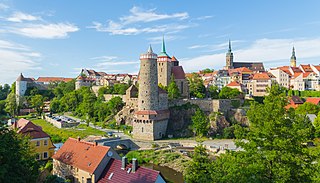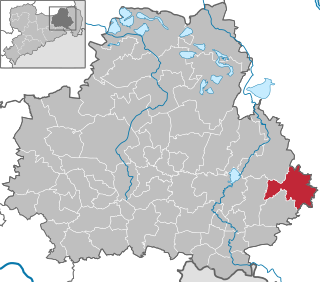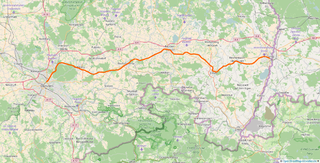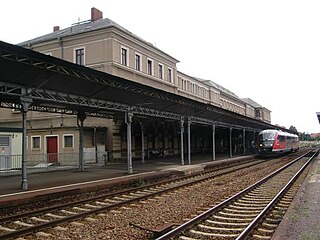
Saxony, officially the Free State of Saxony, is a landlocked state of Germany, bordering the states of Brandenburg, Saxony-Anhalt, Thuringia, Bavaria, as well as the countries of Poland and the Czech Republic. Its capital is Dresden, and its largest city is Leipzig. Saxony is the tenth largest of Germany's sixteen states, with an area of 18,413 square kilometres (7,109 sq mi), and the sixth most populous, with more than 4 million inhabitants.

Lusatia is a historical region in Central Europe, split between Germany and Poland. Lusatia stretches from the Bóbr and Kwisa rivers in the east to the Pulsnitz and Black Elster rivers in the west, and is located within the German states of Saxony and Brandenburg as well as in the Polish voivodeships of Lower Silesia and Lubusz. Lusatia's central rivers are the Spree and the Lusatian Neisse, which constitutes the border between Germany and Poland. The Lusatian Mountains, separate Lusatia from Bohemia in the south. Lusatia is traditionally divided into Upper Lusatia and Lower Lusatia.
The district of Bautzen is a district in the state of Saxony in Germany. Its largest towns are Bautzen, Bischofswerda, Kamenz, Hoyerswerda and Radeberg. It is the biggest district in Saxony by area, and a member of the Neisse Euroregion.

Bautzen or Budyšin, until 1868 Budissin in German, is a town in eastern Saxony, Germany, and the administrative centre of the district of Bautzen. It is located on the Spree river, is the eighth most populous town in Saxony, and is the seat of Saxony's largest district. Bautzen lies in the bilingual Sorbian settlement area of Lusatia, and is Lusatia's third-largest town after Cottbus and Görlitz, as well as the second-largest town in Upper Lusatia.

Löbau is a city in the east of Saxony, Germany, in the traditional region of Upper Lusatia. It is situated between the slopes of the Löbauer Berg and the fertile hilly area of the Upper Lusatian Mountains. It is the gateway to this volcanic mountainous area and is situated halfway between the cities of Bautzen, Görlitz and Zittau.

The Battle of Bautzen was one of the last battles of the Eastern Front during World War II in Europe. It was fought on the extreme southern flank of the Spremberg-Torgau Offensive, seeing days of pitched street fighting between forces of the Polish Second Army under elements of the Soviet 52nd Army and 5th Guards Army on one side and elements of German Army Group Center in the form of the remnants of the 4th Panzer and 17th armies on the other.

Weißenberg (German) or Wóspork is a town in the district of Bautzen, in Saxony, Germany. The Upper Lusatian town has approximately 3100 inhabitants and is part of the recognized Sorbian settlement area in Saxony.

The Diocese of Dresden–Meissen is a Latin Church diocese of Catholic Church in Germany with its seat in Dresden. It is suffragan to the Archdiocese of Berlin.

The Fußballspielvereinigung Budissa Bautzen is a German association football club from Bautzen, Saxony. Founded as Fußballclub Budissa Bautzen on 24 May 1904, the club participated in East German football after World War II.

Demitz-Thumitz (German) or Zemicy-Tumicy is a municipality in the east of Saxony, Germany. It belongs to the district of Bautzen.
Oberlichtenau is a village and a former municipality in the district of Bautzen, in Saxony. Since 1 January 2009, it is part of the town Pulsnitz.
Karl Gustav (Guido) Brescius was a German railway engineer.

The Görlitz–Dresden railway is a two-track main line railway in the German state of Saxony, originally built and operated by the Saxon-Silesian Railway Company. It runs through Upper Lusatia from Dresden via Bischofswerda, Bautzen and Löbau to Görlitz. The line is part of the route from Dresden to Wrocław and Pan-European Transport Corridor III. The first section of the line opened in 1845 and it is one of the oldest lines in Germany.

Bautzen/Budyšin is a railway station in the town of Bautzen, Saxony, Germany. The station lies on the Görlitz–Dresden railway line and the Bautzen–Bad Schandau railway line, the latter now not running to Bautzen. The station is also on the former Bautzen–Hoyerswerda railway.

Kreishauptmannschaft is a German historical term that may refer to a historical type of administrative division in Germany, especially in the Kingdom of Saxony.

Bautzen II was a 20th-century political prison in the town of Bautzen in Saxony operational during the communist regime in East Germany. It was the only East German prison directly under the control of the Stasi.

The Bautzen Reichstag constituency was constituency No. 3 in the Kingdom of Saxony which returned a deputy to the Reichstag of the German Empire. It is based upon the towns of Bautzen, Kamenz and Bischofswerda.

Kreishauptmannschaft Dresden was a Kreishauptmannschaft or administrative district in the Kingdom of Saxony. It was founded in 1835 and continued under the Free State of Saxony until it was merged with Kreishauptmannschaft Bautzen in 1934 Dresden.
Kreishauptmannschaft Leipzig was a Kreishauptmannschaft or administrative district in the Kingdom of Saxony. Succeeding the Leipziger Kreis of the Electorate of Saxony, it was founded in 1835 and continued under the Free State of Saxony until being renamed the 'Regierungsbezirk Leipzig' in 1939, headed by Erich Teichmann (1882-?) as Regierungspräsident. The Kreishauptmannschaft system was abolished in 1943.

Marja Kubašec was a Sorbian writer who is considered by literary historians to be the first woman to write novels in Upper Sorbian. Working as a schoolteacher, she wrote theatre plays, short stories, biographies, and novels dealing with the history of the Sorbian people.
















